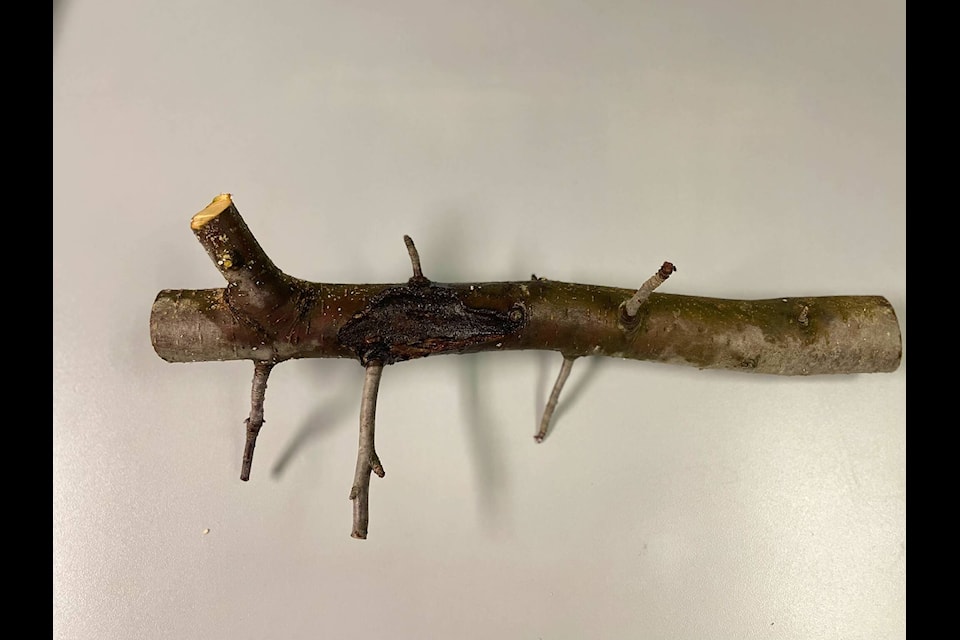An unexpected menace is encroaching upon the vibrant foliage of Terrace.
In a recent interview, local orchardist Charles Claus delved into the threats posed to apple trees in Terrace by tiny maggots.
Claus is concerned that Terrace might soon be affected accidentally by the maggots.
The maggots can be easily transported to Terrace when people buy apples in the lower mainland and process them in Terrace.
Apples with bad spots are often thrown in the compost pile. But they could also be infected by apple maggots and once they get to the city and get established, they could breed and spread further.
Maggots infest apples by crawling inside, causing damage to the fruit. Adults lays eggs directly and after maturity, they exit the apple and live in the soil beneath the tree.
“If people discover a fruit infested by maggots, the easiest way to manage the fruit is to burn it,” said Claus.
Claus said last fall was a good apple time in Terrace with and with the cost of food nowadays, it was a decent source of local food.
“The spread of apple maggots is real threat to one aspect of local food security,” Claus said. A research study produced by the City of Terrace, and regional district found that apple production in Terrace is one of the hidden crops..”
The Canadian Food Inspection Agency (CFIA) has confirmed the presence of apple maggot (Rhagoletis pomonella) in non-commercial trees in the Fraser Valley, Greater Vancouver, Vancouver Island and Prince George.
The Okanagan, and Similkameen and Creston valleys of British Columbia remain the only commercial apple producing regions in North America free of the pest.
The CFIA and Ministry of Agriculture have issued guidelines to prevent the spread of this pest from the Lower Mainland and Prince George to the B.C interior commercial apple production areas.
The ministry has also advised people not to take any host fruit, fruit bins or other containers used to hold apples out of the Lower Mainland, Vancouver Island, or Prince George.
Additionally it says people should not to take plants with garden soil that were grown near host trees out of the Lower Mainland, Vancouver Island, or Prince George.
A suspicious fruit can also be sent to the provincial plant health diagnostic laboratory for a free diagnosis. The infested apples should not be composted, the fruit should be sealed in a plastic bag and buried at least 30 cm deep or taken to a local landfill for burial.
Claus is also concerned about anthracnose canker, a fungus that infects and kills patches of bark on young trees and on the younger woods of the older trees. It is rarely witnessed in Okanagan, but is rampant in coastal BC because of incessant fall rains that promote the infections.
Anthracnose canker is also one of the main reasons why apples are not grown commercially on a significant scale in coastal BC as there is no effective way known to manage and control this disease. The disease is influenced by environmental factors, moisture in particular. It grows in the fall temperatures and early spring.
“It is the biggest challenge in Terrace,” Claus said. “The first step in learning how to manage canker is to learn how to recognize it.”
It is usually a brown, dark brown or reddish fungus that might only be the size of half of a dime. During the pruning of the trees, one should go through the trees and look at the branches thoroughly and cut off the infected parts. If its a smaller branch, it should be cut out completely.
However, if it’s on the main branch of the tree, one should cut the infected part thoroughly. The part above and specially below the infected area should also be cut.
“It’s just like cancer surgery,” Claus said. A paste made of lime spread on the affected area and brushed with a steel brush can fight any remaining anthracnose cells in the tree.
“Lime sulphur, dormant oil and copper spray can slow down the spread of the infection but the best way is to just prune it out.”
Black knot is another fungal disease, infecting cherry and plum trees.
It is spread more intensively in wild trees than domestic ones because of lack of attention. Black knot can be treated by dabbing 50 per cent bleach water onto the affected area. Applying sulphur and copper paste are some of the other ways to deal with the disease.
The apple and pear trees can also be infected by web worm which is easier to control by spraying an organic pesticide called BTK which is found to have very low risk to human health.
Claus said more people need to be aware of the web worm.
“The ministry of agriculture could do more in the way of communication and education to the public,” he said. “I’ve never seen the government spend money on making people aware of the apple maggot in this area.”
Lack of knowledge and awareness cause the spread of diseases which affect local fruit trees, the orchardist added.
READ MORE: It’s official. Thornhill welcomes you
